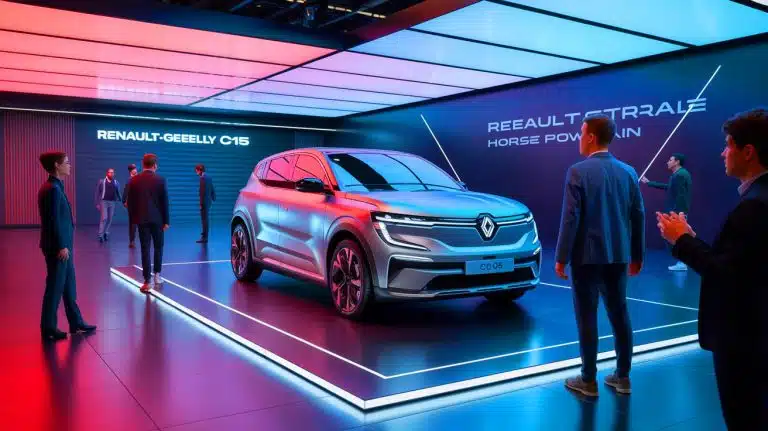| IN A NUTSHELL |
|
In a world gradually shifting away from traditional combustion engines, the recent unveiling of alternative powertrain technologies by the Renault-Geely joint venture, Horse Powertrain Limited, at the Munich IAA 2025, has sparked widespread interest. As global skepticism around battery-electric vehicles (BEVs) grows, this partnership between European and Chinese automakers aims to explore hybrid and range-extending technology. The showcase highlighted several groundbreaking innovations, including the compact Horse Powertrain C15 engine, a future hybrid system, and advancements in electric motor efficiency. These developments could potentially reshape the landscape of vehicle propulsion systems and offer new pathways for the automobile industry’s evolution.
Horse Powertrain C15: Compact and Versatile
At the heart of Horse Powertrain’s exhibit was the C15 engine, a 1.5-liter inline four-cylinder marvel designed for versatility and compactness. Measuring just 19.7 x 21.7 x 10.8 inches, it is engineered to fit seamlessly into vehicles of various sizes. This engine can operate in multiple orientations, whether vertical, horizontal, or any angle in between, making it adaptable to diverse vehicle architectures. In its naturally aspirated form, the C15 produces 94 horsepower, suitable for C-segment or smaller vehicles. When turbocharged, its output increases to 161 horsepower, making it viable for D-segment or light-commercial vehicles.
Beyond its size and power, the C15 engine is engineered to meet stringent emissions standards, such as SULEV20, Euro 7, and China 7. It is capable of running on gasoline, ethanol, methanol flex fuels, and synthetic fuels, enhancing its adaptability in a rapidly changing automotive landscape. While specifics on mass and cost remain undisclosed, the C15’s innovative design could make it a compelling option for manufacturers seeking efficient and flexible powertrain solutions.
Volkswagen Unleashes Its Own Epic Gymkhana Video – A Thrilling Ride!
Advancements in Hybrid Systems
Horse Powertrain’s future hybrid system represents a significant leap in integrating traditional combustion and electric vehicle technologies. Initially showcased in Shanghai, this system transforms existing vehicles into hybrid electric vehicles (HEVs) or plug-in hybrid electric vehicles (PHEVs). The system incorporates a 1.5-liter inline four-cylinder engine, transmission, motor, and power electronics into a single, cohesive unit. Customers can choose between configurations with one or two motors, depending on power needs and vehicle applications.
The “ultra-compact” variant of this system measures 25.6 inches wide, while the two-motor version extends to 29.1 inches. Although the output of the ultra-compact version remains undisclosed, the two-motor configuration boasts an impressive output of 349 horsepower and 380 lb-ft of torque. These innovative systems could provide automakers with a scalable, adaptable solution for incorporating hybrid technology into their vehicle lineups.
Efficiency Through Amorphous Iron Stators
One of the standout innovations presented by Horse Powertrain is the development of the amorphous iron stator. This component plays a crucial role in the efficiency of electric motors, as it conducts electricity through copper windings to produce a magnetic field. Horse Powertrain has managed to reduce the thickness of these steel plates to a mere 0.02 millimeters, compared to the typical 0.20 to 0.25 millimeters. This reduction significantly minimizes eddy-current losses and heat generation, resulting in improved motor efficiency.
The use of amorphous steel, also known as metallic glass, further enhances this efficiency by reducing iron losses by over 50 percent and achieving a motor efficiency of 98.2 percent. Despite the challenges associated with mass-producing such thin plates, Horse Powertrain claims to have developed a viable process involving rapid heating and cooling. These advancements could herald a new era of efficiency for electric motors in automotive applications.
Innovative GaN High Efficiency Generator
Another breakthrough from Horse Powertrain is the integration of a gallium-nitride (GaN) power module into its high-efficiency generator. GaN technology offers ultra-high-speed switching capabilities and superior thermal performance compared to traditional silicon chips. This not only allows for a more compact generator design but also enhances its operational temperature range from -40 to 230 degrees Fahrenheit.
The GaN-powered generator produces 67 horsepower at 4,500 rpm with a remarkable 95-percent efficiency. By combining high efficiency with compact design, this generator could revolutionize range-extender applications for hybrid and electric vehicles. The possibility of these technologies appearing in models from brands like Volvo or Polestar, which are part of the Geely and Renault portfolio, suggests a promising future for these innovations.
As the automobile industry navigates the complex transition away from traditional combustion engines, the innovations showcased by Horse Powertrain Limited highlight the potential of hybrid and range-extending technologies. These advancements offer a glimpse into a future where efficiency and adaptability are paramount. How might these developments influence the broader industry, and what challenges must be addressed to ensure their widespread adoption?
Did you like it? 4.7/5 (23)








Wow, this sounds like a game-changer! 🚗 Can’t wait to see it in action.
Wow, the C15 engine sounds amazing! But do we really need more hybrid tech? 🤔
Is this really going to “save” gas engines or just extend their life a little longer?
Finally, some innovation in the auto industry that isn’t just about electric cars! Thank you, Renault and Geely!
What about the cost? Will these new engines be affordable for the average consumer?
How does the amorphous iron stator compare to traditional stators in terms of durability?
Finally, some innovation that doesn’t just scream “go electric or go home”!
Is this partnership going to be the end of fully electric vehicles? I’m curious to see what happens. 🚗
I’m skeptical. Sounds too good to be true. 🤔
Great news for those of us who love the sound of a gas engine! But how much will it cost?
This might just be the push the hybrid market needs to thrive!
I don’t understand how these advancements will help with emissions? Anyone?
How long until we see these in mass production?
Renault and Geely should focus on making cars fly instead! 😄
Renault-Geely? That’s a partnership I didn’t see coming! What a combo! 😲